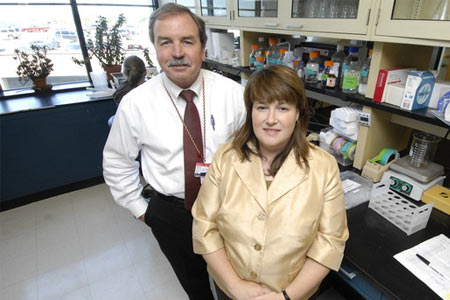Lymphangioleiomyomatosis (LAM) a rare lung disease seemingly occurs when an unusual type of cell invades the lungs. This ailment may affect women and often lead to tissue destruction by creating holes or cysts in the lung. A latest study led by the experts from the University of Cincinnati and Cincinnati Children’s Hospital Medical Center possibly discovered a particular blood test to detect this ailment in some patients.
This disclosure possibly drives out the necessity of undergoing a surgical lung biopsy in order to prescribe an accurate diagnosis. Patients with this illness tend to report shortness of breath and lung collapse termed as pneumothorax. LAM has apparently proved fatal in many cases.
The findings of this study may not only aid in diagnosing LAM, but probably helps in screening for LAM in women with Tuberous Sclerosis Complex (TSC). Many tumors seemingly form in various different organs in TSC, which is a genetic disorder. The authors explained that TSC is considered to be a risk factor for the development of LAM.
Lisa Young, MD, lead author on the study and researcher at UC and Cincinnati Children’s shared, “We concluded that a serum VEGF-D level of greater than 800 pg/mL (picograms, or one-trillionth of a gram, per milliliter) in women with typical cystic changes on a high-resolution computed tomography (CT) scan is diagnostically specific for sporadic LAM and identifies LAM in women with TSC. However, negative VEGF-D results do not exclude the diagnosis of LAM.â€
The experts possibly aimed to examine the quantity of the protein vascular endothelial growth factor-D, or VEGF-D in patients’ blood. This VEGF-D is assumed to enhance the growth of lymphatic vessels and blood vessels. It is also believed to actively involve in the spread of cancer. During the study, 195 women were seemingly subjected to VEGF-D testing. After analyzing the results of the test, the authors mentioned an extreme presence of serum VEGF-D levels in women with LAM, as compared to women with other lung diseases or healthy individuals.
Frank McCormack, MD, senior author and director of pulmonary, critical care and sleep medicine at UC highlighted, “This was a team effort by clinicians around the world to collect blood samples and clinical data from patients with very rare lung diseases. Through their efforts and the generosity of patients who participated, we are optimistic that serum VEGF-D will join the ranks of diagnostic tests for lung disease, reduce the need for surgical lung biopsy and allow for intervention and trial recruitment earlier in the disease course.â€
The scientists considerably scrutinized the VEGF-D test performance in women prior to knowing their diagnosis. As a result, the test registered a high accuracy for diagnosis of LAM. Frank affirmed that Serum VEGF-D measurement is at present a part of the study protocol, but will soon be made available for clinical application.
The study is published in the July 6, 2010, edition of the journal CHEST.

